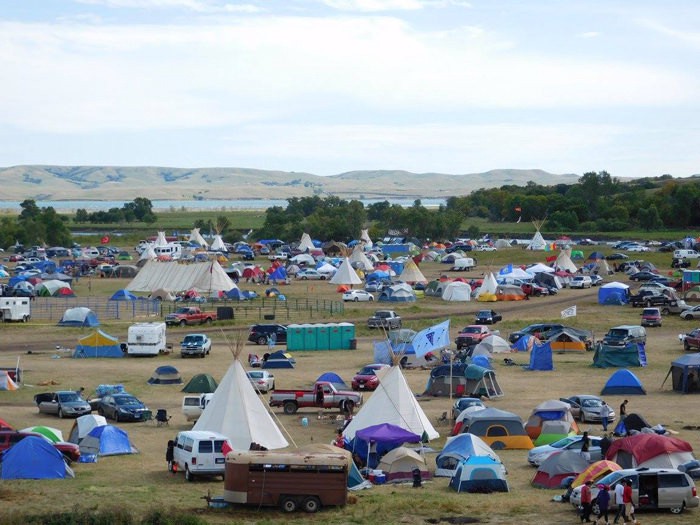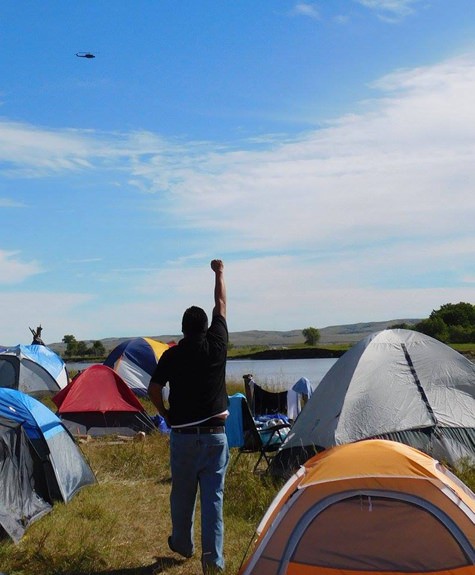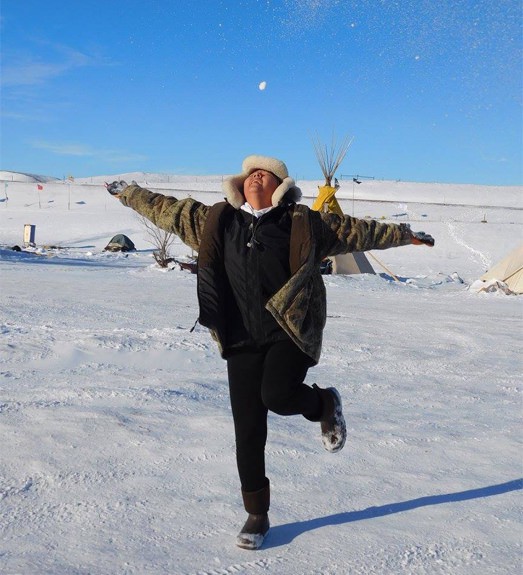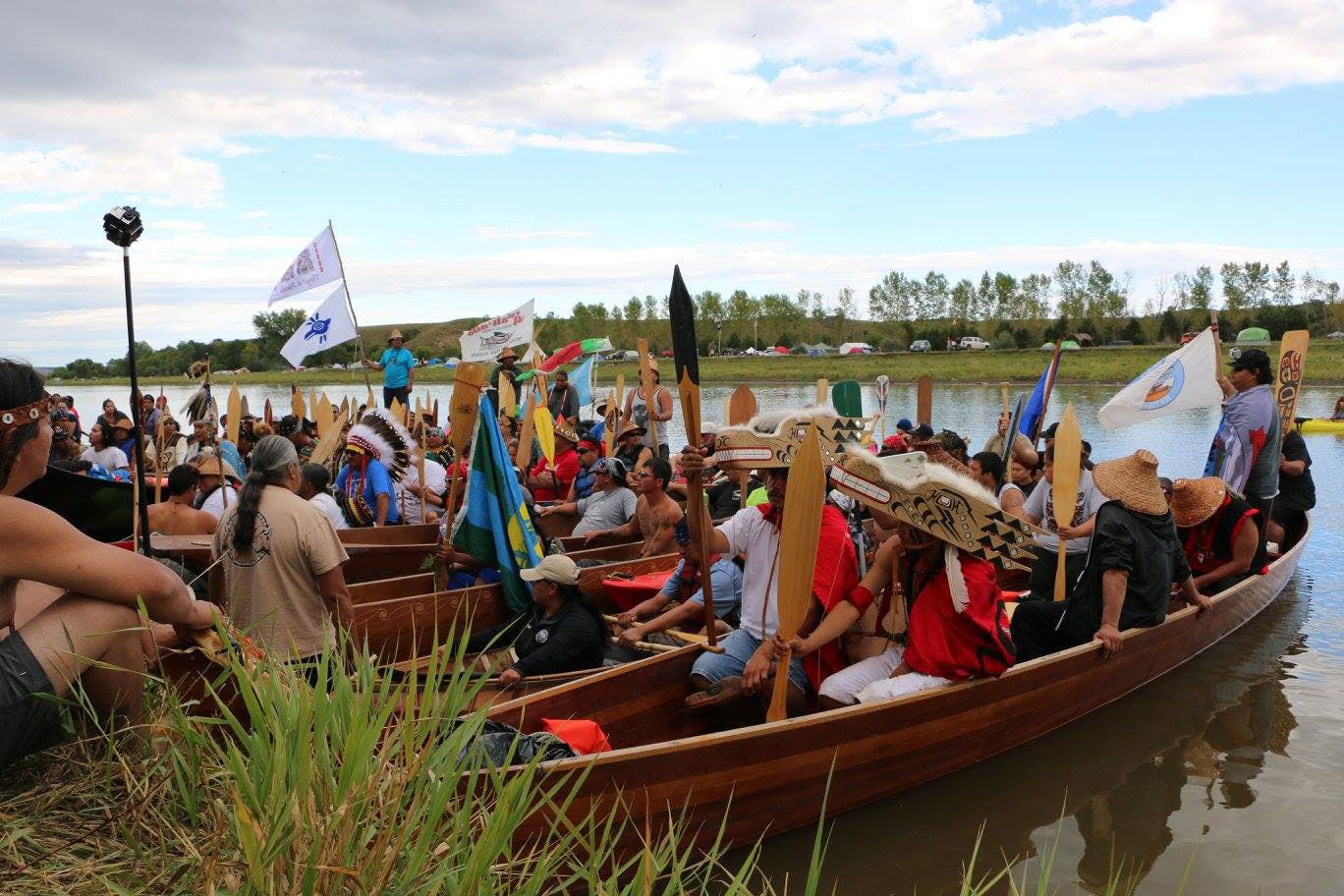The Sacred Fire of Standing Rock Still Burns
Two years after the first #NoDAPL camp was built, a Water Protector shares memories of fighting pipelines at Oceti Sakowin Camp.
Indigenous activists arriving at Standing Rock by canoe in September 2016.
Every morning in the Oceti Sakowin Camp started out with a wakeup call before sunrise, coming over the loudspeaker at around 4:30. “Hihanni waste [good morning], Warriors!” Vic Camp, a member of the Oglala Nation, would greet us. “It’s time to wake up! Remember why you’re here! Load your pipes and meet at the South Gate. It’s time to pray. Sundancers, wake up! Remember why you’re here!”
Before the camps got bigger, the wakeup would only be played on the Sacred Fire Circle speakers. But as the camps grew, and thousands upon thousands came, announcers started driving around the camps with speakers in their trucks, so everyone would hear the call. The International Indigenous Youth Council camp would wake each other up in our council tipi, and make sure we were all at the morning prayers.
I spent 5 months at Oceti Sakowin, from August to December 2016. Everybody would gather at the South Gate every morning, and we would sing the Lakota pipe-loading song with the pipe carriers as they loaded their canupas, sacred pipes. We would smoke canupa, and pray with each other and for each other. We would pray for safety for ourselves and Mother Earth. Then we would head out to either halt construction for the day, or to pray where pipeline workers were desecrating the earth.

The view of Oceti Sakowin Camp from Media Hill, as greater numbers of Water Protectors began to arrive.
So much love was shared by everyone. We gathered and shared laughs. Not much changed after the thousands came either, except that there was a lot more love and laughter, and then some. There was a sense of breathtaking goodness when you drove down into that river valley and saw the tipis and tents set up by the thousands. A layer of campfire smoke came every evening along with a murmur of songs coming from all the different camps of different nations. At the Sacred Fire Circle there was always another nation sharing a story or singing a song. There were elders sitting around sharing stories of the old times.
We were all there for the Earth. For the People. For the water. We were there for the future.
You could walk up to any camp and share a meal. There was always a way to be helping and contributing to the camps’ society. I think the best part was that it wasn’t a monetary society. It was like the old days. We traded food for labor. We bartered songs for stories. We had round dances. We had socials.
The young sat with the old and learned what it was to be an Indigenous person. We learned culture and traditions. We learned how to live in a good way with good intentions. We learned that money wasn’t everything. We learned that we are people of the Earth and we need to go back to that. We lived like old souls. Money wasn’t an issue. It wasn’t what we were centered around or why we gathered. We were all there for the Earth. For the People. For the water. We were there for the future.
Pre-Columbian ways were being brought back and it was so goddamn amazing.
It’s not quite a feeling you can put into words. It was a feeling I will never ever forget for as long as I am alive. I will tell my children and my children’s children about it, and how the entire Indigenous population of our continent was reborn from it. Literally, there were Indigenous nations from across the Americas that came to be with each other again, just like we did before colonization. Pre-Columbian ways were being brought back and it was so goddamn amazing.
Every day when we would come back to camp from wherever the construction was happening, there would be food and our family waiting for us. People would greet you, tell you that they love you. They would smudge you off with cedar and sage and offer you food, ask you how your day was. There wasn’t a “sense” of family at Oceti, we are a family. Some of us have never known what a real family felt like, some of us have never felt that kind of love before. No matter what kind of trauma went on that day, we had love back at camp waiting for us to return.

A Water Protector at Oceti Sakowin raises a fist at a surveillance helicopter.
There were times when every encounter with law enforcement was worse than the last. Every time we engaged with them, it became “the worst thing” I’ve witnessed. Over and over again, it got worse every time. More people got hurt, more people got arrested, the jails got colder, and there were more and more officers showing up.
The Morton County Sheriff’s Department used countless fear tactics on Water Protectors: constant drones, airplanes, and helicopters flying overhead, so low that you’d swear they were going to land on top of you. Sometimes they would tap into our radio conversations. One time, after the raid on sacred grounds, we overheard someone saying, “We’re going to smoke your peace pipes tonight.” So many things went undocumented, or were censored out through mainstream news outlets and social media sites.
But no matter what was happening at the actions, we stayed unarmed, we stayed in prayer. This was a ceremony. As much of a “tourist site” as mainstream media made it out to be, that portrayal was far from the truth. It was a prayerful, traditional ceremony. We were in ceremony constantly. Every time you stepped foot in those camps, it was a ceremony. We prayed. We danced. We shared stories and songs. We shared culture and traditions. We were always in prayer. Always. Praying for the water. For the people. For life.
This is why weapons and other explicit items were not allowed in the camps. You wouldn’t bring alcohol, guns, and drugs into a church, would you? Well, the same rules applied for the camps. That was a sacred place. It still is. The spirits were there guiding us, praying with us, singing with us, and loving with us. We had designated persons that held security positions, and they would be set up at the entrance (North Gate) and exit (South Gate). At the entrance, they would ask why you were there and who you knew in camp. They would ask if you had any drugs, alcohol or weapons with you.

Water Protector Lauren Howland, a member of the International Indigenous Youth Council, photographed on the Council’s last day at Oceti Sakowin.
Oceti Sakowin was a camp full of prayer, laughter, family, and unconditional love for the Earth that we all live on. The #NoDAPL fight that happened on the Standing Rock Reservation was one of the most beautiful things some of us will ever witness. Just like the Wounded Knee Occupation, it was a moment that created change.
A fire was lit in Oceti Sakowin, a fire that every single person who was there, who watched, who supported, carries with them everywhere that they go. They spread that fire in the work that they do for our youth, for our Earth, for the world.
